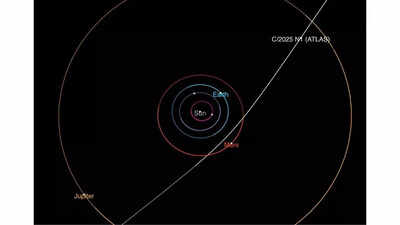ARTICLE AD BOX

Astronomers have identified a mysterious new object hurtling through our
solar system
, believed to have originated from interstellar space. First spotted on July 2, 2025, by the ATLAS survey telescope in Chile, the object — now officially named
3I/Atlas
(C/2025 N1) — marks only the third known interstellar visitor after ‘Oumuamua in 2017 and
comet
2I/Borisov in 2019. Currently traveling at a blistering speed of 60 km/s and located around 416 million miles from the sun, the object appears to be on a hyperbolic trajectory, suggesting it likely came from beyond our solar system. NASA has confirmed that it poses no threat to Earth.
NASA Confirms third known interstellar visitor
The object, initially designated A11pl3Z, was discovered by the
Asteroid
Terrestrial-impact Last Alert System (ATLAS) in Chile. NASA and other observatories later traced its path back to June 14, confirming a hyperbolic orbit that strongly suggests interstellar origins. Now named 3I/Atlas, it joins a short list of confirmed
cosmic wanderers
, offering fresh evidence that such objects may be more common in the galaxy than previously believed. The object is currently approaching the inner solar system from the direction of the constellation Sagittarius.
Comet or asteroid? Scientists still investigating
Though first assumed to be an asteroid, recent observations revealed subtle signs of comet-like activity. The Minor Planet Center noted a faint coma and a short tail, prompting its dual classification as C/2025 N1. Early brightness led some to estimate its size at around 20 kilometers in diameter, but experts now suggest that the dust cloud surrounding the object may be exaggerating its appearance, and the solid core is likely smaller. It is expected to reach its closest point to the sun around October 30, coming just within the orbit of Mars.
No risk to Earth, but a cosmic spectacle awaits
While its origin may be extraordinary, NASA reassures that 3I/Atlas will remain at a safe distance from Earth, never coming closer than about 150 million miles. As it nears the sun, the object may brighten and become visible through amateur telescopes in late 2025 and early 2026. The Virtual Telescope Project is planning a live broadcast for enthusiasts eager to witness this rare phenomenon. Scientists hope that studying this object will provide valuable insights into the composition and behavior of interstellar bodies.



.png)
.png)
.png)
















 4 hours ago
7
4 hours ago
7









 English (US) ·
English (US) ·